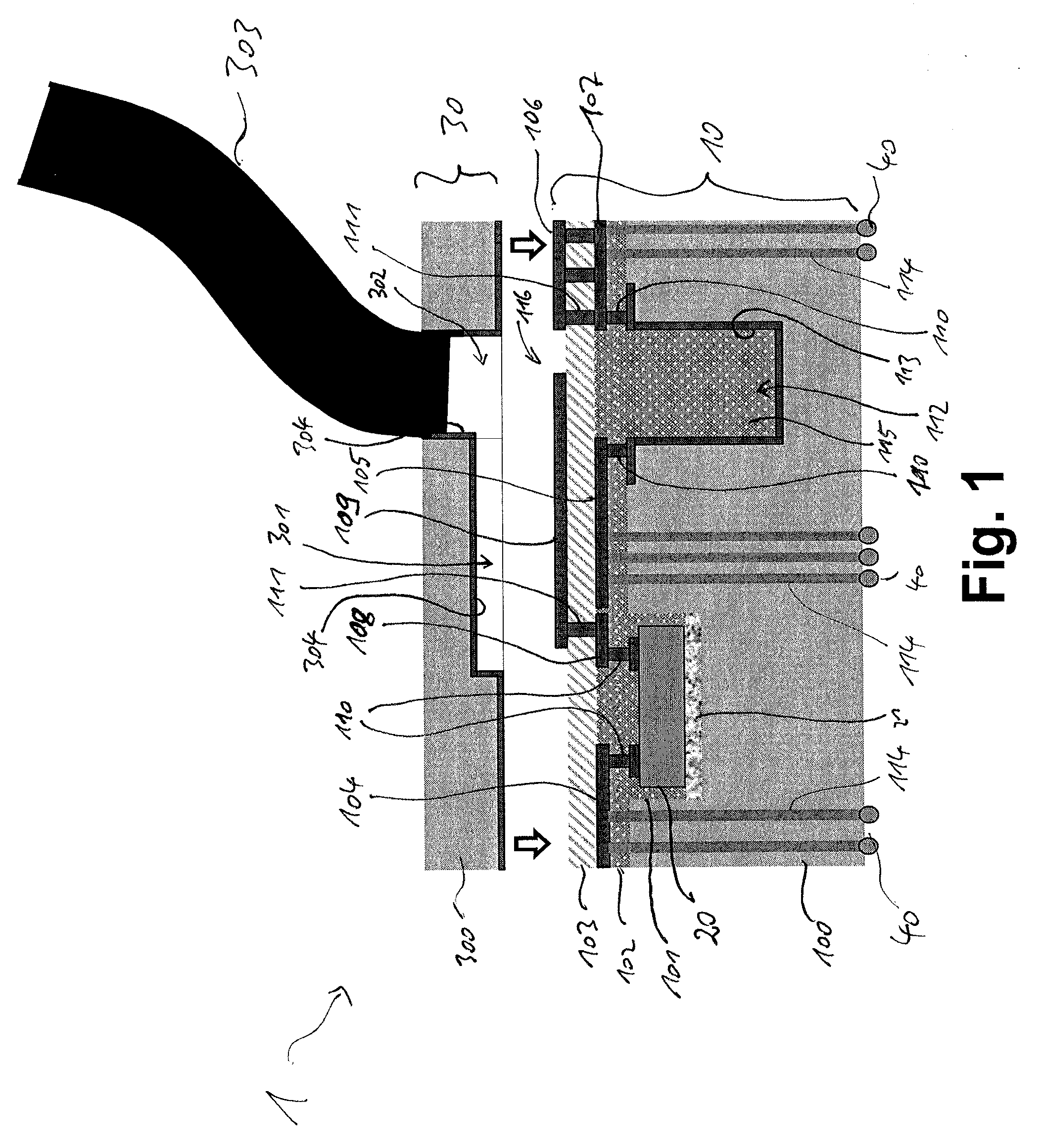Package and antenna apparatus including package
a technology of antenna apparatus and package, applied in the field of package, can solve the problems of increasing noise figure, high cost of low-loss pcb substrate, and very limited frequency approach, and achieve the effects of low manufacturing cost, high repeatability, and low loss
- Summary
- Abstract
- Description
- Claims
- Application Information
AI Technical Summary
Benefits of technology
Problems solved by technology
Method used
Image
Examples
first embodiment
[0056]Referring now to the drawings, wherein like reference numerals designate identical or corresponding parts throughout the several views, FIG. 1 shows a cross section of a package 1 in an intermediate manufacturing stage according to the present disclosure. FIG. 2 shows the same package 1 in a final manufacturing stage. The package 1 comprises a carrier structure 10, one (or more) electronic component(s) 20, e.g. an MMIC, and a cover structure 30.
[0057]The carrier structure 10 comprises a silicon-based carrier layer 100 comprising one (or more) cavity (cavities) 101 for placing (embedding) the one (or more) electronic components 20 therein. The carrier layer 100 may e.g. be a low resistive silicon wafer since it is relatively cheap compared to high resistive silicon wafers. A first polymer layer 102 is formed on top of the carrier layer 100, and a second polymer layer 103 is formed on top of the first polymer layer 102. Metallization layers 104-109 are provided for use as signal...
second embodiment
[0066]Another possibility of antenna integration into the silicon package is depicted in FIG. 5A and FIG. 5B. FIG. 5A shows across section of a package 2 according to the present disclosure and FIG. 5B shows a top of the package 2 having a carrier structure 11 and a cover structure 31. In addition to the rectangular waveguide 305 formed by a trench etched into the cover layer 300, another rectangular waveguide 117 is formed by another trench etched into the silicon-based carrier layer 100 opposite the waveguide 305. These trenches 305, 117 together form a complete rectangular waveguide. In the center of this waveguide a probe feed is realized by a microstrip-to-waveguide transition 116. Alternatively a loop feed 118 can be employed. The probe or the loop, respectively, may be fabricated on a polymer membrane. This membrane consists of the first polymer layer 102 and the second polymer layer 103, which are both applied as thin films. A backshort 119 of a quarter guided wavelength may...
third embodiment
[0068]FIG. 6A shows a cross section of a package 3 according to the present disclosure and FIG. 6B shows a top view of the package 3 having a carrier structure 12 and a cover structure 32. In this embodiment inline feeding of a rectangular waveguide formed by a metallization layer 124 and a trench 306 in the cover layer 300 is used. Therefore, the microstrip line 109 is fed through a hole in the backside wall of a rectangular waveguide. The microstrip line 109 is preferably terminated in a loop 118, which is formed by the microstrip line 109 and a via 125 to the metallization layer 124. An antenna array can either be formed by open-ended. waveguides in the side wall of the package 3 or by horn apertures 123.
PUM
 Login to View More
Login to View More Abstract
Description
Claims
Application Information
 Login to View More
Login to View More - R&D
- Intellectual Property
- Life Sciences
- Materials
- Tech Scout
- Unparalleled Data Quality
- Higher Quality Content
- 60% Fewer Hallucinations
Browse by: Latest US Patents, China's latest patents, Technical Efficacy Thesaurus, Application Domain, Technology Topic, Popular Technical Reports.
© 2025 PatSnap. All rights reserved.Legal|Privacy policy|Modern Slavery Act Transparency Statement|Sitemap|About US| Contact US: help@patsnap.com



